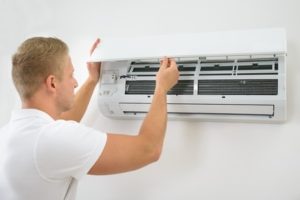Presidential Heating & Air Conditioning
Gaithersburg HVAC Contractors
Share
Share on FacebookTweet
Tweet this0Share
Share on LinkedIn0 shares on LinkedInI. The Air Conditioner: An Invention That Changed Lives
 Air conditioning was invented in 1902 by an electrical engineer named Willis Haviland Carrier. His purpose in this invention was to lower the humidity in the air at a New York City publishing company, Sackett-Wilhelms Lithographing and Publishing Company. By lowering the humidity in the plant, the paper could better absorb the ink being used in the printing process of that era. Carrier accomplished this simply by blowing the air inside the building across cold pipes. When the air passed over the cold pipes, the pipes drew the heat out of the air, and the air cooled. Cooler air cannot carry as much moisture as warmer air. Cooling the air thus lowered the humidity in the building. This process also lowered the air temperature. The air conditioner was born!
Air conditioning was invented in 1902 by an electrical engineer named Willis Haviland Carrier. His purpose in this invention was to lower the humidity in the air at a New York City publishing company, Sackett-Wilhelms Lithographing and Publishing Company. By lowering the humidity in the plant, the paper could better absorb the ink being used in the printing process of that era. Carrier accomplished this simply by blowing the air inside the building across cold pipes. When the air passed over the cold pipes, the pipes drew the heat out of the air, and the air cooled. Cooler air cannot carry as much moisture as warmer air. Cooling the air thus lowered the humidity in the building. This process also lowered the air temperature. The air conditioner was born!
It was not until the 1960’s before air conditioning became affordable for the average homeowner. Almost everyone has an air conditioner in their home today. A recent survey by the US Energy Information Administration shows that 87 percent of United States households now have air conditioning.
II. Modern Air Conditioners
Your air conditioner of today works on the same principles as the original invention—by drawing the heat out of the room. An air conditioner is much like a refrigerator. In fact, modern air conditioners use refrigerants. Refrigerants are chemical compounds that facilitate the laws of physics when moisture in the air is converted to a gas through the evaporation process, like boiling water evaporates as vapor into the air.
When the refrigerant evaporates and converts from liquid form to gas, it naturally reduces the heat. You have experienced this when you rub alcohol on your skin. It cools immediately. That cooling sensation is the evaporation of the alcohol evaporating and taking the heat from your skin. Then, when the refrigerant condenses and converts from gas back to liquid, it expels the heat. Your air conditioner forces these refrigerants to evaporate and condense repeatedly through the coils inside the air conditioner.
III. Putting It All Together: The Cooling Process in Your Air Conditioner
Fans inside your air conditioner suck the air from your room and push it across the refrigerated coils of an evaporator. The refrigerant inside the evaporator coils absorbs the heat. As the evaporator absorbs the heat, the refrigerant inside changes from a cool liquid into a warm gas vapor. At the same time, the air that had heat removed from it went from being warmer to cooler. The cooler air is blown back into your room.
From the evaporator, the vaporized gas goes into a compressor. The compressor is located outside the home. The compressor compresses the vaporized gas to a higher pressure and higher temperature.
The warmer, pressurized gas then travels to the condenser. In the condenser, the gas condenses back to its cooler liquid form and expels the heat out into the air. If you have ever stood next to the unit outside, you have probably felt the heated air being blown out of it. That heat is the hot air that has been pulled out of your room.
The cooled liquid is then moved back inside into an expansion device. The expansion device simply controls the flow of the cool liquid refrigerant into the evaporator. Then the process begins all over again—the evaporator coils will absorb heat as the refrigerant changes from a cool liquid into a warm, low-pressure gas.
IV. Humidity Control
In addition to cooling the air, air conditioners reduce the humidity in the air. Just as the first air conditioner did in 1902, the coils of the evaporator not only absorb the heat, they also pull the moisture out of the air. The moisture is drained out of the unit.
V. Air Conditioning Maintenance
Your air conditioner is one of the most expensive systems in your home. The Department of Energy recommends yearly maintenance to keep your system performing in peak condition. It pays to have a licensed professional HVAC contractor inspect and tune your air conditioning system regularly. If you are having problems with your system, a professional technician can identify and diagnose them and keep up with small repairs before they become major expenses.
If your system needs to be replaced, a professional HVAC contractor can help you choose a new system that is the right size for your home, take care of the installation, and make sure it is operating properly. With a new system, you may be able to extend its life with regular, routine maintenance right from the beginning.


